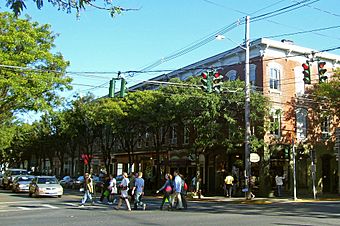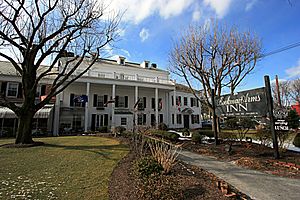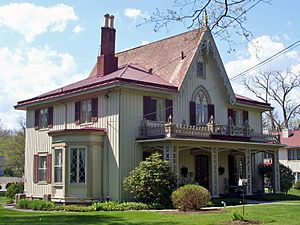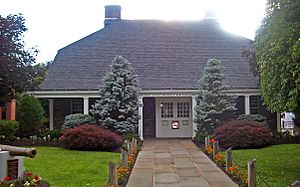Rhinebeck Village Historic District facts for kids
|
Rhinebeck Village Historic District
|
|

|
|
| Location | Rhinebeck, NY |
|---|---|
| Area | 167 acres (68 ha) |
| Built | 18th-early 20th centuries |
| Architect | Stephen McCarty, R. Decker |
| Architectural style | Colonial, Greek Revival, Late Victorian |
| NRHP reference No. | 79001578 (original) 100006011 (increase) |
Quick facts for kids Significant dates |
|
| Added to NRHP | August 8, 1979 |
| Boundary increase | January 15, 2021 |
The Rhinebeck Village Historic District is a special area in Rhinebeck, New York. It's located along US 9 and NY 308. This district covers about 167 acres and has 272 buildings. These buildings show many different architectural styles from over 200 years of history.
This area was officially recognized as a historic district in 1979. It was added to the National Register of Historic Places because it has so many well-preserved old buildings. Most of its properties were built from the Colonial era up to the late 1800s.
Many important people have visited this area. Three U.S. presidents have passed through Rhinebeck. One famous visitor was Franklin D. Roosevelt. In the 1930s, he even helped choose the design for the new post office here. Today, this post office is one of the historic buildings in the district. The area is now a popular spot with many unique shops and small businesses. Its streets are beautiful, lined with large shade trees and old sidewalks.
Exploring Rhinebeck's Historic Area
The Rhinebeck Village Historic District is right in the center of the village. Its borders are a bit uneven because they follow property lines. Most of the historic buildings are in the neighborhoods northeast of where Route 9 and Route 308 meet.
The district includes several streets, either fully or in part. For example, all of Center and Livingston streets are inside the district. Parts of Mulberry and North Parsonage streets are also included.
Most of the land within the district is developed. It's mainly a residential area, meaning people live there. However, you'll find businesses concentrated on the tree-lined streets near the main intersection of Route 9 and Route 308. Larger shops are east of this junction. Smaller storefronts stretch several blocks east along East Market Street (Route 308).
The district also has important public buildings. There are three churches, the town and village halls, and the fire station. All these buildings show different architectural styles from the 1800s and early 1900s. These styles range from Colonial to Colonial Revival.
A Look Back: Rhinebeck's History
European settlers first came to the Rhinebeck area in 1686. A group of Dutch people crossed the river from Kingston. They bought about 2,200 acres of land from the local Iroquois tribes. The name Rhinebeck comes from Wilhelmus (William) Beekman, who founded the town. It also includes "Rhineland," which was his hometown.
Later, Wilhelmus Beekman's son, Col. Henry Beekman, got a special patent for the land. He wanted to see the area grow. He brought in Caspar Landsman, a miller, and William Traphagen, a builder.
In 1703, the New York colonial government approved money for the King's Highway. This road is now known as the Albany Post Road and is mostly Route 9 today. Three years later, Traphagen bought land where the King's Highway met an old Native American trail. This trail is now Market Street. He built a house and a tavern there. This was the very beginning of Rhinebeck.
Around 1715, Beekman's son brought 35 Palatine Germans to the village. These people had left their homes because of religious problems. They had tried to make naval supplies for the British government further north. The village grew quickly with these new arrivals. New businesses started, and in 1733, the Reformed Dutch Church was built. Its first building was where the current church stands today. In 1766, the first parts of the current Beekman Inn were built. It has been a hotel ever since, making it very old!
In the mid-1770s, a soldier named Richard Montgomery moved to the village. He was married to a member of the Livingston family. He had just started life as a farmer when the Revolution began. He was chosen for the New York Provincial Congress and became a general in the Continental Army. He sadly died in 1775 during the Battle of Quebec. His old cottage is still standing. It was moved to 77 Livingston Street and now houses a local Daughters of the American Revolution group. The street it was on was later named in his honor.
After independence, the village kept growing. The Town of Rhinebeck was formed in 1788. The current Dutch Reformed Church was built in 1802. This makes it the oldest church building in the village. East Market Street was laid out in the same year.
Rhinebeck continued to attract important people. George Washington visited in 1796. He ate at a tavern and stayed at a friend's house nearby. During the 1804 election for governor, both Aaron Burr and Morgan Lewis used taverns in Rhinebeck as their campaign offices.
The village became an official incorporated village in 1834. Ten years later, a famous architect named Alexander Jackson Davis built the Henry Delamater House at 44 Montgomery Street. This house is still there today. It's a great example of the early Gothic Revival style in American homes.
By the 1850s, Rhinebeck was known for its woodworking. Furniture from Rhinebeck was considered high quality. It was even shipped as far away as South Carolina. People said Rhinebeck was the best at making carriages, coaches, and sleighs. Some clothing makers also became famous across the country. The area also became a popular place for wealthy families to build large country estates during the Gilded Age.
In the late 1880s, a president-elect visited the village. Levi P. Morton lived in Rhinebeck. He had been a congressman and an ambassador to France. Benjamin Harrison chose him to be his running mate in the 1888 election. Harrison was visiting Morton in Rhinebeck when they found out they had won the election. Later, Morton also served as governor.
The end of the 1800s brought a new business to Rhinebeck: growing violets. About 20% of the village's population worked in this business. The total value of the violet crop was sometimes over a million dollars a year! Several of the "violet houses" built during this time are still part of the historic district today.
An 1890 map of the village shows that it was almost the same size as today's historic district. The area has mostly stayed the same since then. A third president, Franklin D. Roosevelt, who lived nearby in Hyde Park, also played a role in the town's history. During the Great Depression, he helped with the design of the new post office. He liked using Dutch-style fieldstone for public buildings in the area. He told the architects to use Henry Beekman's old house as a model. Some of its remaining stones were even used for the post office.
Protecting Rhinebeck's History
The village of Rhinebeck has special rules to protect its historic character. Along Route 9, there's a "special sensitivity" zone. This helps keep the historic look of the area that most visitors see. These rules say that new homes must look like single family houses. Businesses in this area should not look too much like businesses from the outside.
The village and town also have plans to protect their historic places. They want to make sure new buildings and renovations fit in with the old ones. They ask the town historian to list all known historic sites. They also want any important buildings not yet listed to be added to the National Register of Historic Places.






